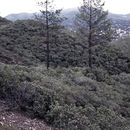Evolutionary distribution
provided by EOL authors
The entire Arctostaphylos genus is situated in a monophyletic clade or sub-family known as the Arbutoideae, which is populated by taxa having bright fleshy berries with fibrous or bony endocarp.. Evolution of the genus is relatively recent, with hybridization playing an important role; however, convergent evolution patterns appear to complicate cladistic constructions for certain portions of the genus cladogram. In any case, fossil ancestors of the Arctostaphylos genus have been suggested to have occurred in the Middle Miocene, with modern species beginning to take shape in the Late Tertiary. It has been further posited that in the earlier Tertiary a greater species diversity was present, influenced by influence of floristic influence of southwestern North America ancestors. This hypothesis also suggests that the present palette of California Arctostaphylos species became more depauperate upon arrival of a cooler drier climate in the Late Tertiary.These evolutionary views are coincident with other research that points to fire-dependent plant associations developing in the Late Miocene in California. Present species distribution of Arctostaphylos nissenana is restricted to a limited extent of the Sierra Nevada foothills, chiefly in El Dorado County, California.
- bibliographic citation
- C.Michael Hogan. 2012. Arctostaphylos. Encyclopedia of Earth. Eds. M. McGinley & C.Cleveland. National council for Science and the Environment. Washington DC
- author
- C. Michael Hogan (cmichaelhogan)
Arctostaphylos nissenana: Brief Summary
provided by wikipedia EN
Arctostaphylos nissenana is a species of manzanita known by the common name Nissenan manzanita. It is endemic to California, where it grows in the woodlands and chaparral of the Sierra Nevada foothills, mostly in El Dorado County.
- license
- cc-by-sa-3.0
- copyright
- Wikipedia authors and editors

